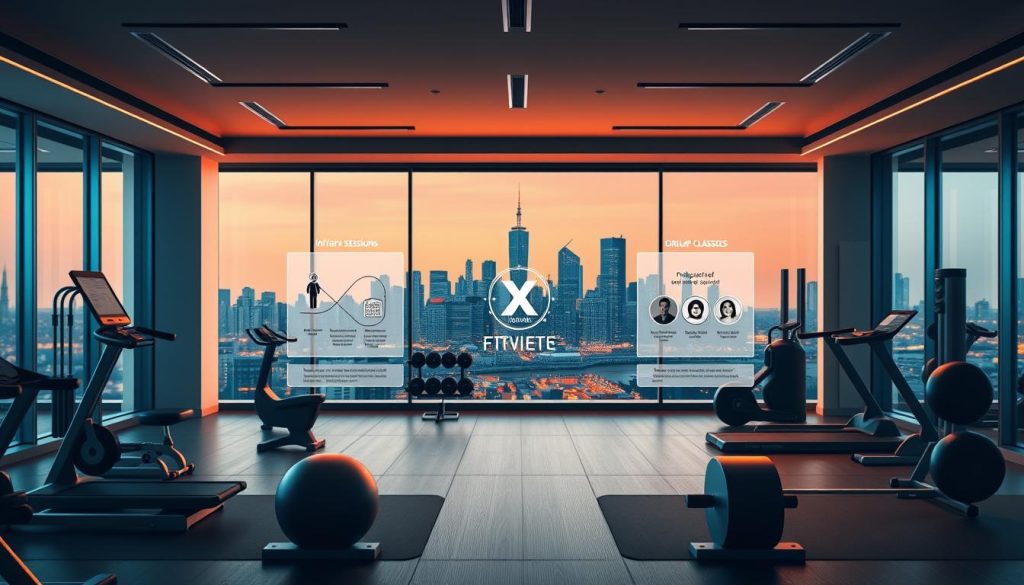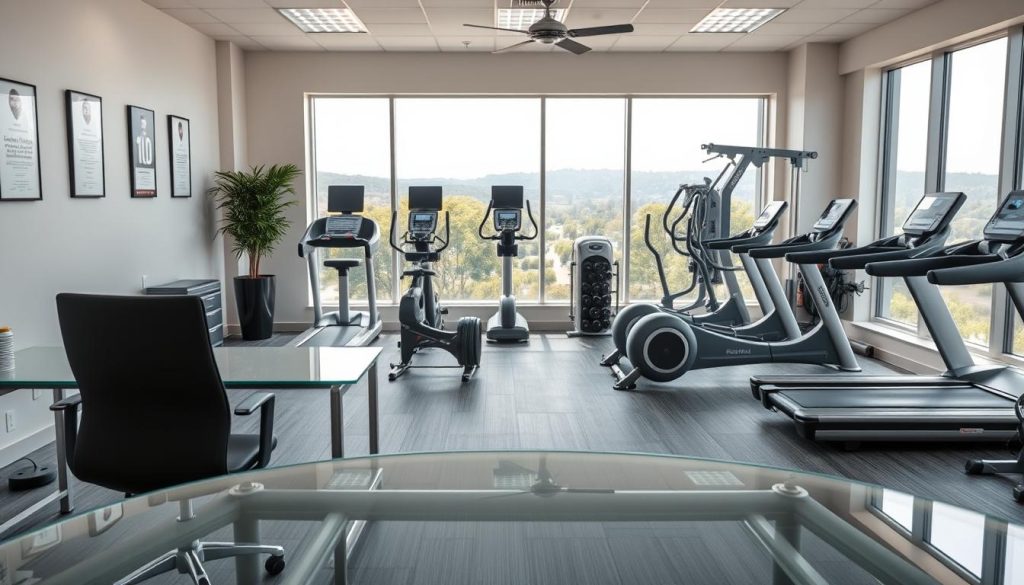Imagine having a fitness expert who comes to you. A freelance personal trainer offers exactly that service. These professionals work independently to provide customized coaching.
They bring their expertise directly to clients in various locations. Sessions can happen at homes, local parks, or gyms. Many also offer convenient online coaching options.
This career path offers incredible flexibility and independence. In fact, studies show most fitness professionals choose this self-employed model. It’s a growing trend in the wellness industry.
The real value comes from personalized attention. Each workout plan adapts to individual goals and lifestyles. This approach delivers better results and keeps clients motivated.
Building a successful practice requires trust and professionalism. Clients seek guidance, accountability, and expert knowledge. It’s a rewarding career that makes a real impact on people’s health.
Table of Contents
Key Takeaways
- Independent fitness professionals offer flexible training in various locations
- Customized workout plans adapt to individual client needs and goals
- Online coaching provides convenient options for busy schedules
- Self-employed trainers represent a growing segment of the fitness industry
- Success depends on building trust through professional expertise
- Personal attention leads to better motivation and results
- This career path offers opportunities for business growth and development
What is a Freelance Personal Trainer?
Operating as your own boss in the fitness world offers unique opportunities and challenges. These independent professionals build complete wellness businesses from scratch.
They handle every aspect of their operation themselves. This includes finding clients, setting rates, and managing schedules. Administrative tasks like marketing and finances also fall under their responsibility.
This differs significantly from employed fitness coaches who work at gyms. Those professionals typically receive fixed salaries and have costs covered by their employers. Independent operators enjoy more control but also carry more responsibility.
One major advantage is choosing where to conduct sessions. Work can happen at client homes, local parks, or through online platforms. This flexibility creates diverse income streams.
« Building your own fitness business means creating something that truly reflects your values and expertise. »
Financial management requires attention to taxes, insurance, and licensing. Liability coverage protects both the professional and their clients. Proper business registration ensures legal operation.
Client relationships become deeply personalized in this model. Each workout plan adapts to individual goals and lifestyles. Nutrition guidance often complements physical training programs.
Success demands strong self-motivation and business skills. Marketing yourself effectively helps attract the right clients. Time management ensures balanced work and personal life.
The greatest reward comes from witnessing client transformations. Helping people achieve their health goals creates meaningful impact. This career path offers both financial and personal fulfillment.
Real-world examples include professionals working in Paris parks, offering home sessions in Lyon, and providing online coaching across France. Each creates their unique business model based on local needs.
The Pros and Cons of Being a Freelance Personal Trainer
Choosing the independent route in fitness brings both exciting opportunities and real challenges. Every career path has its bright spots and shadow areas worth considering.
Understanding both sides helps you make informed decisions. This balanced view prepares you for success in the wellness field.

Advantages of the Freelance Path
One major benefit is complete control over your schedule. You decide when to work and when to take time off.
This flexibility allows for better work-life balance. You can accommodate family needs and personal commitments easily.
Financial rewards often exceed traditional employment. Without gym commissions, you keep all earnings from your sessions.
Many independent professionals set premium rates for their expertise. This significantly boosts their earning potential over time.
Work variety keeps each day interesting and fresh. You might train clients in parks, homes, or through online platforms.
Building a strong brand reflects your unique approach to wellness. Your training style becomes your signature offering in the market.
The deep satisfaction from client transformations remains priceless. Watching people achieve their health goals brings incredible fulfillment.
Challenges to Consider
Income stability requires constant attention to client acquisition. Building a solid client base takes time and consistent effort.
Business operations demand diverse skills beyond fitness expertise. You handle marketing, finances, and administration alone.
Employee benefits like health insurance become personal responsibilities. Financial planning becomes crucial for long-term security.
Equipment costs and gym access present practical hurdles. Investing in quality gear ensures professional service delivery.
The competitive market demands continuous self-promotion. Standing out requires creativity and persistence in your outreach.
Seasonal fluctuations can affect client consistency. Summer vacations and holiday periods might impact your regular income.
Smart strategies help overcome these obstacles. Networking with other wellness professionals creates referral opportunities.
Diversifying your services cushions against market changes. Offering nutrition guidance alongside physical training adds value.
Despite the challenges, many find the independence worth the effort. The freedom to build something truly yours remains powerfully attractive.
Step 1: Get Certified and Insured
Your journey begins with proper credentials. Accreditation shows you meet industry standards.
Organizations like NASM, ACE, and ISSA offer respected programs. These certifications validate your knowledge and skills.
Liability insurance protects your practice. It covers potential accidents during sessions.
This coverage gives clients confidence in your services. It shows you take safety seriously.
Business licensing varies by location. Check local requirements before starting your operations.
Additional credentials like CPR/AED add value. Emergency preparedness demonstrates complete care.
Certification exams test essential knowledge. They cover anatomy, program design, and safety protocols.
« Proper credentials build immediate trust with potential clients and establish professional credibility from day one. »
Choosing the right program depends on your goals. Specializations can focus on specific populations or techniques.
Consider costs and time commitments carefully. Quality education requires investment but pays dividends.
Ongoing education keeps your skills current. The fitness industry evolves constantly with new research.
Renewal requirements ensure you stay updated. Continuing education credits maintain your certifications.
| Certification Type | Average Cost | Study Time | Renewal Period |
|---|---|---|---|
| NASM CPT | $699 | 3-4 months | 2 years |
| ACE Health Coach | $599 | 4-6 months | 2 years |
| ISSA Nutritionist | $799 | 3-5 months | 2 years |
| CPR/AED | $75 | 4 hours | 2 years |
This foundation prepares you for success. Clients seek professionals with verified expertise.
Your credentials become part of your brand. They differentiate you in a competitive market.
Insurance provides peace of mind. It allows you to focus on client development without worry.
These steps might seem challenging initially. They create long-term security for your career growth.
Step 2: Choose Your Personal Training Business Model
Selecting the right operational framework shapes your entire career path. Your business model determines how you interact with clients and structure your income.
Three main approaches dominate the independent fitness landscape. Each offers distinct advantages for different working styles and target audiences.

Starting with one model simplifies your initial setup. You can always expand your services later as your client base grows.
In-Person Training
Traditional face-to-face sessions remain highly popular. You meet clients at their homes, local parks, or commercial gyms.
This approach offers immediate feedback and hands-on correction. The personal connection often leads to stronger client relationships.
Travel between locations becomes part of your routine. Keep detailed mileage records for potential tax deductions.
Equipment needs vary based on your training locations. Portable resistance bands and mats work well for park sessions.
Successful trainers in Paris often use beautiful urban parks as their workout studios. Others build thriving practices visiting client homes across different arrondissements.
Online Coaching
Digital training breaks geographical limitations. You can work with clients anywhere through video platforms and custom apps.
This model offers incredible scheduling flexibility. You create workout programs that clients complete on their own time.
Technology requirements include reliable internet and video conferencing tools. Many platforms offer built-in payment processing and scheduling features.
Communication happens through messaging apps and weekly check-ins. You provide guidance and motivation remotely.
Online coaching has enabled French trainers to work with international clients. Some specialize in nutrition guidance alongside digital workout plans.
Hybrid Model
Combining approaches creates income stability. You maintain some in-person sessions while developing online services.
This balance protects against seasonal fluctuations. When local clients travel, you continue their programs remotely.
The hybrid approach requires careful time management. You’ll need systems for both physical and digital client interactions.
Many successful professionals start with one method then add the other. This gradual expansion builds sustainable business growth.
Several top Paris-based trainers use this blended approach. They offer studio sessions plus online programs for traveling executives.
« The right business model aligns with your strengths and serves your ideal clients most effectively. »
Consider your target audience when choosing your approach. Urban professionals might prefer online flexibility while suburban families often want home visits.
Your initial choice doesn’t lock you into one path forever. Many freelancers evolve their business models as they gain experience.
Start simple with one primary method. Master that approach before expanding your service offerings.
Step 3: Define Your Niche to Stand Out
Finding your special focus area transforms your fitness career. Instead of serving everyone, you become the expert for specific groups.
This approach makes you stand out in a crowded field. People prefer specialists who understand their unique needs.
Think about busy professionals who want weight loss results. Or new mothers seeking strength and energy restoration.
Senior fitness represents another valuable specialty. Each group requires different approaches and understanding.
Your marketing becomes much more effective with a clear focus. You can create messages that speak directly to your ideal clients.
« Specialization builds immediate credibility and makes client acquisition significantly easier. »
Trust develops faster when you demonstrate specific expertise. Clients feel confident you understand their particular situation.
Consider these successful niche examples:
- Post-rehabilitation training for injury recovery
- Nutrition-focused programs for weight management
- Strength development for athletic performance
- Mobility improvement for older adults
Choosing your focus should combine personal passion with market demand. What excites you most about health and wellness?
Also consider where needs exist in your local area. Some neighborhoods might lack certain specialty services.
Many successful professionals in France have built thriving practices this way. One Paris-based expert focuses exclusively on corporate wellness programs.
Another in Lyon specializes in postpartum fitness. Both found their unique space in the market.
Continuous learning within your chosen area maintains your edge. Stay updated on the latest research and techniques.
This commitment to excellence keeps clients loyal. They appreciate working with someone who truly understands their journey.
Your niche becomes your professional signature. It’s what makes you different from other fitness professionals.
This specificity actually makes growing your business easier. You know exactly who you’re trying to reach and help.
Step 4: Set Up Your Business Fundamentals
Getting your operational systems right creates a strong foundation for growth. Proper setup saves you time and prevents headaches down the road.
Start with a dedicated business bank account. This separates your personal and professional finances clearly.

Bookkeeping becomes much easier with separate accounts. You’ll track income and expenses without confusion.
Legal documents protect both you and your clients. Contracts outline services, payment terms, and cancellation policies.
PAR-Q forms assess client health readiness. These questionnaires identify potential medical concerns.
« Solid business systems create professional credibility and operational efficiency from day one. »
Liability waivers provide additional protection. They acknowledge inherent risks in physical activity.
Scheduling software streamlines your calendar management. Clients can book sessions online at their convenience.
Payment systems should be simple and reliable. Automated billing reduces administrative tasks significantly.
Tax deductions help maximize your earnings. Keep records of all business-related expenses.
Marketing costs, website development, and equipment purchases qualify. Even your home office space might be deductible.
Accounting software simplifies financial tracking. Choose user-friendly platforms designed for small businesses.
These tools generate reports for tax preparation. They help you understand your financial health clearly.
Insurance remains non-negotiable for protection. General liability coverage safeguards against accidents.
Business registration varies by location in France. Check local requirements for proper licensing.
Client records need organized management systems. Digital files ensure easy access and backup security.
Compliance with data protection laws is essential. Client information requires careful handling.
Automating administrative tasks saves valuable time. You can focus more on actual coaching work.
Common pitfalls include mixing personal and business finances. Another mistake is inadequate documentation.
Starting with organized systems prevents these issues. Your future self will thank you for the effort.
| Business Element | Purpose | Recommended Tools | Frequency |
|---|---|---|---|
| Business Bank Account | Financial separation | Local banks, online banking | Ongoing |
| Accounting Software | Expense tracking | QuickBooks, FreshBooks | Weekly updates |
| Scheduling System | Session management | Acuity, Calendly | Daily use |
| Legal Documents | Client protection | Custom templates | Per client |
| Tax Records | Deduction tracking | Spreadsheets, receipts | Monthly organization |
These fundamentals support sustainable growth. They create professionalism that clients appreciate.
Your business becomes more efficient with proper systems. You can scale your services without chaos.
Investing time in setup pays long-term dividends. It’s worth doing right from the beginning.
Step 5: Build a Simple and Strong Brand
Your brand represents your professional identity in the fitness world. It’s how people recognize and remember your unique approach to health.
A clear brand helps you stand out from other professionals. It communicates your values and specialty without lengthy explanations.
Start with basic but essential elements. Create a simple logo that reflects your training style.
Secure consistent social media handles across platforms. Build a clean one-page website that highlights your services.
Avoid perfectionism in these early stages. Many successful professionals started with simple, functional branding.
« Your brand should tell a story about who you are and how you help people achieve their goals. »
Focus on outcome-driven offers rather than generic services. Instead of « fitness coaching, » try « 12 weeks to your first pull-up. »
This approach speaks directly to client desires. People want specific results, not vague promises.
Consistent visuals create professional recognition. Use the same colors, fonts, and tone across all materials.
Your messaging should match your visual identity. If you specialize in gentle senior fitness, use warm, reassuring language.
Social media builds brand awareness effectively. Share client success stories and educational content regularly.
Platforms like Instagram and Facebook work well for visual demonstrations. LinkedIn connects you with professional clients.
Your website serves as your digital business card. Include testimonials and before-and-after photos when possible.
These elements build trust with potential clients. They see real people achieving real results with your guidance.
Brand differentiation matters in competitive markets. What makes your approach different from other fitness professionals?
Maybe you offer unique outdoor sessions in Paris parks. Perhaps you combine nutrition planning with workout programs.
Authenticity creates lasting client relationships. Your brand should reflect your genuine personality and values.
Don’t try to be something you’re not. Clients appreciate honesty and transparency in their health partners.
Marketing becomes easier with a clear brand identity. You know exactly who you’re trying to reach and help.
Your brand should work across various platforms. From business cards to social media, maintain consistency.
Several successful French professionals built strong brands this way. One Lyon-based expert focuses exclusively on postpartum recovery.
Another in Marseille created a brand around Mediterranean lifestyle fitness. Both found their unique market position.
Your brand evolves as your business grows. Start simple but plan for refinement over time.
The right brand attracts your ideal clients naturally. It speaks directly to the people you want to help most.
This foundation supports all your marketing efforts. A strong brand makes client acquisition much more effective.
Step 6: Acquire Your First Clients
Building your initial client base feels exciting and challenging. This phase transforms your skills into a sustainable business.
Start with people who already know and trust you. Friends, family, and colleagues make perfect first clients.
Offer introductory sessions at special rates. These beta programs help you gain valuable experience while collecting testimonials.

Focus on delivering measurable results from day one. Track progress with simple metrics like weight, strength, or energy levels.
Happy clients become your best marketers. They’ll naturally refer others when they see real changes in their health.
« Your first clients are learning partners who help refine your coaching approach while building social proof. »
Ask for feedback after each session. Use this input to improve your services and training methods.
Create simple systems for collecting testimonials. Video reviews work particularly well for building trust.
Consider these effective strategies from successful professionals:
- One Paris-based expert offered free park sessions to build community visibility
- A Lyon trainer created a « bring a friend » program that doubled her client base
- Many use social media to share client transformation stories
Referral programs incentivize current clients to spread the word. Offer a free session for every new referral.
Patience matters during this building phase. It takes time to establish your reputation and income stream.
Use progress tracking tools like simple apps or spreadsheets. These help demonstrate value to both current and potential clients.
Your niche specialization makes client acquisition easier. You know exactly who needs your unique expertise.
Remember that every successful trainer started with their first client. Your dedication will build momentum over time.
This foundation sets the stage for long-term career growth. Each new client relationship expands your professional network.
Step 7: Master Sales and Marketing for Growth
Growing your fitness practice requires smart promotion and communication skills. These abilities help you connect with more people who need your help.
Learning how to present your services effectively makes a big difference. Good marketing shows your value without being pushy or salesy.
Combining different approaches works best for steady growth. Each method reaches people in slightly different ways.
Your efforts should feel genuine and helpful. People respond better to useful information than constant sales pitches.
Essential Sales Skills
Discovery calls help you understand potential client needs. These conversations explore goals, challenges, and expectations.
Ask open-ended questions that encourage detailed responses. Listen more than you talk during these initial discussions.
Handling objections requires patience and understanding. Common concerns include cost, time commitment, and past experiences.
Address each concern with empathy and factual information. Share success stories that relate to their specific situation.
Closing should feel natural rather than forced. The best sales happen when people feel ready to begin their journey.
« Effective salesmanship means helping people make decisions that improve their lives, not just pushing services. »
Follow-up systems keep potential clients engaged. Gentle reminders show you remember their interests and goals.
Your enthusiasm for their success should shine through. People want to work with someone who believes in their potential.
Effective Marketing Strategies
Social media platforms offer incredible reach for fitness professionals. Instagram and Facebook work particularly well for visual content.
Share workout tips, client successes, and educational content. Behind-the-scenes glimpses build personal connection.
Search engine optimization helps people find your website. Use relevant keywords in your content and page descriptions.
Local SEO targets people in your specific area. This works well for professionals serving particular neighborhoods.
Networking events connect you with potential referral sources. Other wellness professionals often share similar client bases.
Paid advertising can accelerate your visibility. Targeted social media ads reach specific demographics effectively.
Email campaigns maintain relationships with past and potential clients. Newsletters share valuable information and updates.
Content should educate and entertain your audience. Useful tips keep people engaged and coming back for more.
Consistency matters more than perfection in marketing. Regular posting builds familiarity and trust over time.
Measuring results helps you refine your approach. Track which methods bring the most qualified leads.
| Marketing Method | Best For | Time Investment | Cost Range |
|---|---|---|---|
| Social Media | Building community | 3-5 hours weekly | $0-100 monthly |
| SEO Optimization | Long-term visibility | 2-4 hours weekly | $0-200 monthly |
| Networking Events | Local connections | 4-6 hours monthly | $50-150 monthly |
| Paid Advertising | Quick visibility | 2-3 hours weekly | $100-500 monthly |
| Email Campaigns | Client retention | 1-2 hours weekly | $20-100 monthly |
Successful professionals often combine several methods. This balanced approach ensures steady growth.
One Paris-based expert uses Instagram for daily workout tips. She combines this with monthly networking breakfasts.
Another professional in Marseille focuses on local SEO. His website appears when people search for fitness services in his area.
Your marketing should reflect your unique personality and approach. Authenticity attracts the right clients for your business.
Adjust your strategies based on what works best. Marketing requires ongoing attention and refinement.
The goal remains connecting with people who need your help. Good marketing makes that connection happen more often.
Conclusion
Embarking on this journey offers both freedom and responsibility. You gain control over your schedule and income while helping others transform their health.
Remember the essential steps: proper certification, smart business setup, and clear branding. These foundations support sustainable growth and client trust.
Continuous learning keeps your skills relevant in this evolving industry. Adapt to market changes and client needs for long-term success.
Build strong relationships through excellent service and results. Your reputation becomes your most valuable asset over time.
Ready to start? Explore certification programs from organizations like ISSA or Study Active. Their courses provide excellent education for aspiring professionals.
Share your progress or questions in the comments below. Let’s build a community of supportive fitness experts together!
FAQ
What exactly is a freelance personal trainer?
A freelance personal trainer is a fitness professional who operates their own independent business. Instead of working for a gym, they manage their own schedule, find their own clients, and set their own rates. They provide one-on-one or group fitness coaching, either in-person, online, or through a mix of both.
What are the biggest benefits of being a freelance trainer?
The biggest perks include freedom and flexibility. You control your own hours, choose who you work with, and keep all the earnings. You also have the creative freedom to build a brand and training style that’s truly your own.
What challenges should I expect when starting out?
Starting your own business means you’re responsible for everything—finding clients, handling finances, and managing your schedule. It can take time to build a steady client base and income. Also, you’ll need to handle your own taxes, insurance, and marketing.
Do I need special certifications or insurance?
Yes! Getting certified through a recognized organization like ACE, NASM, or ACSM is essential. It proves your expertise and keeps clients safe. Liability insurance is also a must—it protects you and your business in case of accidents.
How do I choose the right business model?
Think about what fits your strengths and goals. In-person training is great for hands-on coaching. Online coaching lets you reach people anywhere. A hybrid model mixes both, offering more flexibility to you and your clients.
Why is defining a niche important?
Focusing on a specific niche—like weight loss, strength training, or postnatal fitness—helps you stand out. It makes you the go-to expert for that area and attracts clients who are looking for exactly what you offer.
What are the first steps to set up my business?
Start by choosing a business name and setting up a separate bank account. Decide on your pricing, create a simple contract for clients, and look into any local permits you might need. Keeping things organized from day one is key.
How can I build a strong brand as a new trainer?
Your brand is your promise to clients. Keep it clear and consistent. Choose a logo and colors that reflect your style. Be authentic in how you communicate, both in person and on social media. People connect with realness!
What’s the best way to get my first clients?
Start with people you know! Offer free sessions to friends and family in exchange for testimonials. Use social media to share valuable fitness tips and let everyone know you’re open for business. Word-of-mouth is powerful.
Any tips for marketing and growing my client base?
Share success stories and educational content on Instagram or Facebook. Collaborate with local health-focused businesses. Ask happy clients for referrals—sometimes a simple ask is all it takes. Consistency and providing great service will help you grow.





